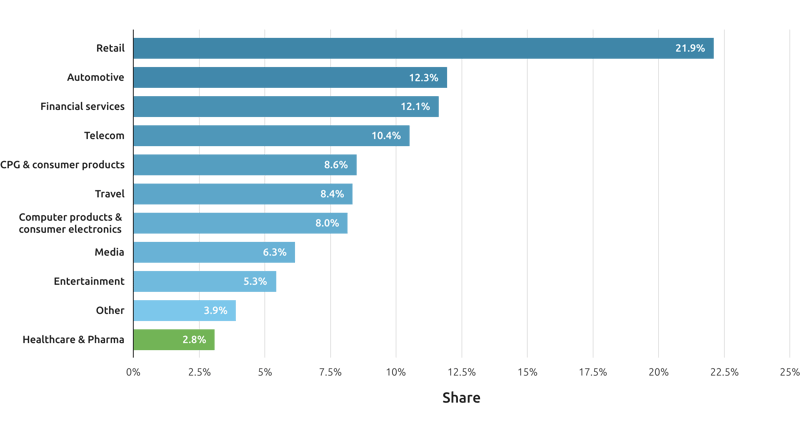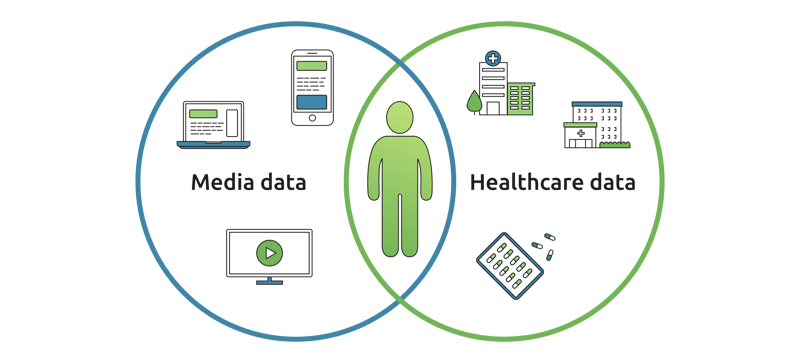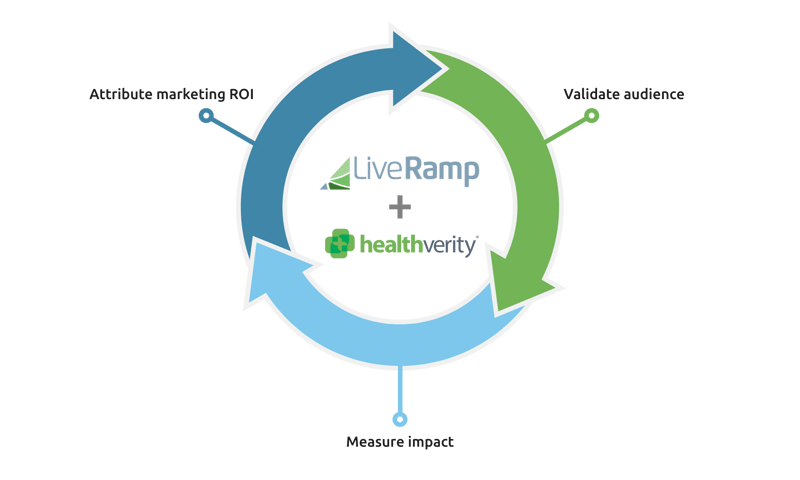Healthcare has the lowest digital ad spend among major industries today. Privacy protection laws such as HIPAA have limited marketers’ ability to measure the impact of their campaigns and put real numbers to their marketing ROI. While pharmaceutical companies can assume their marketing efforts reach the right patients during their journey to treatment, it has been extremely difficult to prove audience quality and attribution until now.  Source: US Healthcare and Pharma Digital Ad Spending 2019
Source: US Healthcare and Pharma Digital Ad Spending 2019
A new media data link connecting patient IDs between the HealthVerity and LiveRamp ecosystems is providing healthcare marketers with an unprecedented view into the patient journey. With HealthVerity Census, the industry-leading de-identification and matching technology, individuals can be tokenized with a unique but persistent HealthVerity ID (HVID), which is then linked to a unique LiveRamp IdentityLink ID (IDL). This HIPAA-compliant bridge offers a direct path into learning how digital campaigns and media impressions are directly impacting patients’ most important healthcare decisions.
The concept of linking healthcare data and media impression data isn’t new. In the past, marketers have been able to ask a set number of questions about how their campaigns are performing and trust that their third-party analytics partner is providing meaningful answers.
Here’s the difference: The HealthVerity-LiveRamp media data link provides healthcare marketers direct access to the underlying transaction-level healthcare data for patients of interest, allowing marketers the freedom to run their analytics of choice rather than relying on a third-party platform to answer a pre-set list of questions. Campaign data can be linked at the patient level to HealthVerity’s ecosystem of over 150 billion de-identified patient transactions, allowing for insights that have never before been possible.
"The media data link brings healthcare organizations the same level of sophisticated marketing attribution that other major industries have enjoyed for decades."
- John Cappiello, Chief Technology Officer, HealthVerity
Reach a qualified audience
When designing a campaign and segmenting a target audience, healthcare marketers are often making a best guess as to who they believe fits the right profile, but they don’t really know for certain. The ability to combine healthcare data with digital touch points such as impressions and website visits finally offers healthcare marketers direct insight into the patients they reach.
Through the new media data link, marketers can leverage healthcare data to validate if the audience exposed to the campaign actually has the related diagnosis or comorbidities they are targeting. Now marketers can see whether they reached the right audience within days after the campaign launches. From there, they can validate if the marketing budget is being invested in the right messaging or channels.
What new questions can be answered now?
- Does the audience who is reached actually have the diagnosis or comorbidities of interest?- In other words, are marketing dollars being used to address the right audience?

Measure ROI by understanding patient behavior
The media data link not only gives marketers the power to validate a campaign audience, but it also offers connectivity to the full ecosystem of 60 interoperable data sources within HealthVerity Marketplace. Plugging into additional longitudinal healthcare and consumer data creates a more comprehensive patient picture for marketers to answer key questions such as: Did the audience we reached visit their physician? Receive a new diagnosis? Initiate treatment on the intended drug?
Healthcare marketers can link campaign data to over 330 million de-identified patients among both open and closed medical claims and pharmacy data as well as EMR, lab results, imaging and hospital chargemaster data. They can visualize healthcare outcomes such as adherence to a new drug, visits to a specialist or overall health patterns before, during and after a media campaign. This interoperability reveals the many actions patients take after interacting with a campaign and how they were influenced along the way.
By licensing the underlying data, however, marketers gain the flexibility to run their own best-in-class analytics and develop their own predictive models. They don’t need to run analytics on a generic third-party platform or have another company run it for them. Linked real-world data to the desktop offers a superior way to measure ROI and ultimately build more effective campaigns.
What new questions can be answered now?
- At what point in the patient journey are patients interacting with the campaign?- Is this specific messaging driving the intended outcomes?
- Do the patients of interest fill a new prescription or make another change?
- Are patients switching from a competitive drug?
"This is an unprecedented level of access to linkable, de-identified healthcare data. Marketing finally has the ability to run their own analytics, develop their own models and come to their own conclusions. It opens up the black box."
- Gabe Richman, Principal, Media and Consumer Data, HealthVerity
Scale and repeat
Measuring real-world outcomes empowers pharmaceutical companies to gauge the impact of campaigns in near-real time. Exposure to the actual patient journey, even on a de-identified basis, means that marketers can refine their strategy at the right time—when they know the right audience will be making their crucial healthcare decisions. 
What new questions can be answered now?
- Based on current patient behaviors, how should the current campaigns be refined?
- How much ROI can be expected from specific marketing tactics next year?
- Which channels resonate the most with certain audiences?
- Where should the budget be spent?
Use Case
A pharmaceutical company initiates a display ad campaign for Drug X, a medication for heart failure, one year after its market launch. The goal of the campaign is to increase prescription fills and overall market share. The healthcare marketing team works with an agency to create audience segmentation intended for outreach.
After the digital ad campaign is live, the healthcare marketing team can generate a list of HVIDs that link to the IDLs of de-identified patients who were exposed to the campaign. Using medical claims data, they can observe if patients exposed to the ad then visit their cardiologist to discuss a new alternative to therapy. The team can also license EMR data to investigate ejection fraction tests and whether the physician wrote a prescription for Drug X or a competitive drug. Then using pharmacy data, they can measure if the prescription was actually filled, along with any other prescriptions patients were already using or had used in the past.
Using consumer data, marketers can delve further into the social determinants of their key audience. They can explore grocery shopping patterns, along with key demographics such as income, education or other important attributes, all in a HIPAA-compliant manner. Based on the results of the campaign and the corresponding prescription fills, the healthcare marketing team can sharpen the composition of their audiences and refine their messaging. With the media data link from HealthVerity and LiveRamp, marketers can now make strategic, data-driven decisions about their optimal marketing channels, prioritize tactics that yield the highest lift and redirect marketing spend to where it will have the greatest impact.
To learn more about how pairing digital touch points such as impressions and website views with patient healthcare and consumer data can dramatically improve your marketing strategy, watch the webinar. You'll hear from John Cappiello, HealthVerity CTO, Reyna Klesh, HealthVerity Senior Director of Data Insights and Kevin Dunn, LiveRamp Managing Director.






